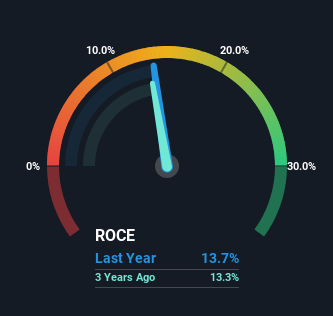Stock Analysis
- Saudi Arabia
- /
- Transportation
- /
- SASE:4260
Returns On Capital At United International Transportation (TADAWUL:4260) Have Stalled

Finding a business that has the potential to grow substantially is not easy, but it is possible if we look at a few key financial metrics. Ideally, a business will show two trends; firstly a growing return on capital employed (ROCE) and secondly, an increasing amount of capital employed. This shows us that it's a compounding machine, able to continually reinvest its earnings back into the business and generate higher returns. That's why when we briefly looked at United International Transportation's (TADAWUL:4260) ROCE trend, we were pretty happy with what we saw.
What Is Return On Capital Employed (ROCE)?
Just to clarify if you're unsure, ROCE is a metric for evaluating how much pre-tax income (in percentage terms) a company earns on the capital invested in its business. Analysts use this formula to calculate it for United International Transportation:
Return on Capital Employed = Earnings Before Interest and Tax (EBIT) ÷ (Total Assets - Current Liabilities)
0.14 = ر.س311m ÷ (ر.س2.8b - ر.س558m) (Based on the trailing twelve months to September 2023).
Thus, United International Transportation has an ROCE of 14%. By itself that's a normal return on capital and it's in line with the industry's average returns of 14%.
Check out our latest analysis for United International Transportation

Above you can see how the current ROCE for United International Transportation compares to its prior returns on capital, but there's only so much you can tell from the past. If you'd like, you can check out the forecasts from the analysts covering United International Transportation here for free.
What Does the ROCE Trend For United International Transportation Tell Us?
The trend of ROCE doesn't stand out much, but returns on a whole are decent. Over the past five years, ROCE has remained relatively flat at around 14% and the business has deployed 96% more capital into its operations. 14% is a pretty standard return, and it provides some comfort knowing that United International Transportation has consistently earned this amount. Over long periods of time, returns like these might not be too exciting, but with consistency they can pay off in terms of share price returns.
The Bottom Line
In the end, United International Transportation has proven its ability to adequately reinvest capital at good rates of return. And the stock has done incredibly well with a 243% return over the last five years, so long term investors are no doubt ecstatic with that result. So while the positive underlying trends may be accounted for by investors, we still think this stock is worth looking into further.
One final note, you should learn about the 2 warning signs we've spotted with United International Transportation (including 1 which is potentially serious) .
While United International Transportation isn't earning the highest return, check out this free list of companies that are earning high returns on equity with solid balance sheets.
Valuation is complex, but we're helping make it simple.
Find out whether United International Transportation is potentially over or undervalued by checking out our comprehensive analysis, which includes fair value estimates, risks and warnings, dividends, insider transactions and financial health.
View the Free AnalysisHave feedback on this article? Concerned about the content? Get in touch with us directly. Alternatively, email editorial-team (at) simplywallst.com.
This article by Simply Wall St is general in nature. We provide commentary based on historical data and analyst forecasts only using an unbiased methodology and our articles are not intended to be financial advice. It does not constitute a recommendation to buy or sell any stock, and does not take account of your objectives, or your financial situation. We aim to bring you long-term focused analysis driven by fundamental data. Note that our analysis may not factor in the latest price-sensitive company announcements or qualitative material. Simply Wall St has no position in any stocks mentioned.
About SASE:4260
United International Transportation
United International Transportation Company, together with its subsidiaries, engages in the leasing and rental of vehicles, and used car sales under the Budget Rent a Car name in Saudi Arabia.
Acceptable track record second-rate dividend payer.

